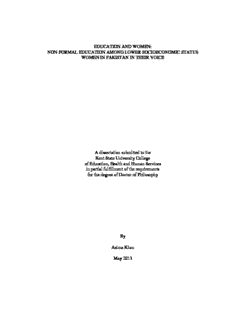
Education and Women: Non-Formal Education Among Lower Socioeconomic Status Women in ... PDF
Preview Education and Women: Non-Formal Education Among Lower Socioeconomic Status Women in ...
EDUCATION AND WOMEN: NON-FORMAL EDUCATION AMONG LOWER SOCIOECONOMIC STATUS WOMEN IN PAKISTAN IN THEIR VOICE A dissertation submitted to the Kent State University College of Education, Health and Human Services in partial fulfillment of the requirements for the degree of Doctor of Philosophy By Asima Khan May 2013 © Copyright, 2013 by Asima Khan All Rights Reserved ii Dissertation written by Asima Khan B.A., Punjab University, 1984 M.A., Kent State University, 2004 Ph.D., Kent State University, 2013 Approved by _________________________, Director, Doctoral Dissertation Committee Vilma Seeberg _________________________, Member, Doctoral Dissertation Committee Averil E. McClelland _________________________, Member, Doctoral Dissertation Committee Hedi Nasheri Accepted by _________________________, Director, School of Foundations, Leadership Shawn Fitzgerald and Administration _________________________, Dean, College of Education, Health and Human Services Daniel F. Mahoney iii SEEBERG, VILMA, Ph.D., May 2013 Foundations, Leadership and Administration EDUCATION AND WOMEN: NON-FORMAL EDUCATION AMONG LOWER SOCIOECONOMIC STATUS WOMEN IN PAKISTAN IN THEIR VOICE (242 pp.) The goal of the study was to examine the facilitative and obstructive factors in accessibility of education, for lower socioeconomic status women and the educational needs of these women. This study followed the qualitative interpretive approach, using semi-structured interviews and field notes. To analyze the coded data Seeberg’s (2011) empowerment capabilities approach was used. The participants were women, fifteen years of age and above, attending literacy training in a rural community in Punjab, Pakistan. The study was helpful in discovering some of the factors that can support women to complete their basic education. However, little evidence was found that showed that some of the socio-cultural obstructions to women’s enrollment were affected or ameliorated. The facilitators that were deduced were: the importance of a ‘mobilizer’ person, a sense of well-being while in an educational setting, flexibility in class timing, proximity to the literacy center, need for helping children with school work, acquiring confidence and socializing. The obstructive factors were: women’s traditional roles, as wives and mothers, son-preference, higher opportunity cost of girls’ education, women’s internalization of lesser status, segregation, ‘purity’ before marriage and poverty. What women wanted was education with the potential of leading to a job. Literacy classes had given the women enough confidence to leave chores unfinished and face criticism from families and community to come to the literacy center. From this it was deduced that continuation of education accompanied by social action can make an impact on women’s empowerment. ACKNOWLEDGEMENTS I want to thank Foundations, Leadership and Administration for providing me with the opportunity to carry out this study. I am extremely grateful to my adviser Dr. Vilma Seeberg for her guidance, every step of the way. I want to thank my committee members Dr. Averil E. McClelland and Dr. Hedi Nasheri for taking out time from their busy schedules to be on my committee, and Dr. Martha Merrill for agreeing to be the graduate faculty member. Finally, I want to thank my sons Omar and Zakriya and my husband Kazim Khan for their encouragement and support, and for rescuing me from my technological fiascoes; as well as my family in Pakistan for their continuous support and prayers. iv TABLE OF CONTENTS Chapter Page I. INTRODUCTION TO THE PROBLEM ................................................................1 Problem Statement ...................................................................................................2 Supports and Constraints for Women’s Education ...............................................11 Poverty .............................................................................................................13 Labor Force Participation of Women in Pakistan ............................................14 Non-Formal Education.....................................................................................15 Need for and Purpose of the Study ........................................................................17 Research Questions ...............................................................................................18 Definition of Terms ...............................................................................................19 Social Class .....................................................................................................19 Feminism..........................................................................................................20 Researcher Role ....................................................................................................20 Personal Interest .....................................................................................................21 Analytical Framework ...........................................................................................23 Implications ...........................................................................................................23 II. REVIEW OF LITERATURE ................................................................................24 Background: On the Sociocultural Influences on Pakistani Women’s Current Educational and Emancipation Status ....................................................24 Patriarchy .........................................................................................................25 Feudalism ........................................................................................................28 Colonialism and Muslim Women ...................................................................31 Non-formal Education and Lower Socioeconomic Status Women .................34 Empowerment as Process ................................................................................36 Current Educational and Emancipation Status of Women: Facilitative and Obstructive Factors ......................................................................................39 Male Dominance ..............................................................................................48 Violence ...........................................................................................................50 Female Sexuality and Segregation ..................................................................52 Women’s Lack of Physical Mobility ...............................................................59 Patriarchal Bargaining ....................................................................................60 Purdah ..............................................................................................................63 Market: Impact on Women’s Literacy and Emancipation ..............................67 v Women’s Access to Land and Other Resources ..............................................69 Women and Urban Migration ..........................................................................71 State Intervention: Impact on Women’s Literacy and Emancipation .............72 Religion ............................................................................................................80 Non-Formal Education and NGOs: Possibilities for Lower SES Women in Developing Countries.........................................................................83 NGO Project Design: Supports and Constraints .............................................85 Participatory Techniques .................................................................................86 Vertical Alliances ............................................................................................88 NGO Project Sustainability: The Role of Participants ...................................90 Women’s Strategic versus Practical Needs......................................................91 The Process of Empowerment .........................................................................94 NGOs and Islamist Resistance .......................................................................106 Successful NFE Programs by NGOs .............................................................108 Summary ..............................................................................................................112 III DESIGN, METHODOLOGY AND ANALYSIS ...............................................121 Design ............................................................................................................121 Setting ...........................................................................................................125 Participants .....................................................................................................128 Data Collection Methods and Procedures ......................................................129 Focus Groups ...........................................................................................131 Interviews .................................................................................................133 Memos......................................................................................................143 Categorizing Strategies/Substantive Categories: Open Coding ...............143 Connecting strategies: axial coding ...................................................144 Data Analysis .................................................................................................144 Summary ........................................................................................................146 IV FINDINGS ...........................................................................................................148 Wellbeing .............................................................................................................149 Enjoyment ......................................................................................................149 Confidence .....................................................................................................150 Cognition: Reason Things Out .....................................................................152 Curious about the Larger World ...................................................................154 Capacity to Aspire .........................................................................................155 Choose Learning/Something Specific ............................................................156 Summary ........................................................................................................157 Agency Freedom ..................................................................................................158 Choose Learning/Speak Up on Own Behalf/Make Strategic Life Choices ...158 Religion ....................................................................................................159 Marriage ...................................................................................................160 Divorce .....................................................................................................162 vi Spinsterhood ............................................................................................163 Summary ........................................................................................................169 Achievement of Capabilities ................................................................................170 Political State or Condition ............................................................................170 Subjective Positionality or Orientation .........................................................171 Achievement as an Objective State or Condition .........................................179 Summary ........................................................................................................180 Individual Stories .................................................................................................180 Conclusion ...........................................................................................................184 V WOMEN’S EDUCATION AND EMPOWERMENT ........................................187 Discussion of Findings: In Relation to Literature Review ...................................189 R.Q.1. Factors which Facilitate Women’s Education ..........................................189 R.Q.2. Factors which Obstruct Women’s Education ..........................................193 R.Q.3. What do Women Want from Education ..................................................199 Poverty, Gender and Education, Equality and Patriarchy ....................................200 Conclusion ...........................................................................................................206 Implications of Research for Public Policy .........................................................207 Implications for Future Research .........................................................................208 APPENDICES .................................................................................................................209 APPENDIX A LETTER OF CONSENT ........................................................................210 APPENDIX B SAMPLE OF AN INTERVIEW WITH PARTICIPANTS.....................213 APPENDIX C SAMPLE OF FIELD NOTES .................................................................225 REFERENCES ................................................................................................................231 vii LIST OF FIGURES Figure Page 1. Map of Pakistan ...................................................................................................126 2. Schematic Map of Naseerabad .............................................................................127 viii
Description: